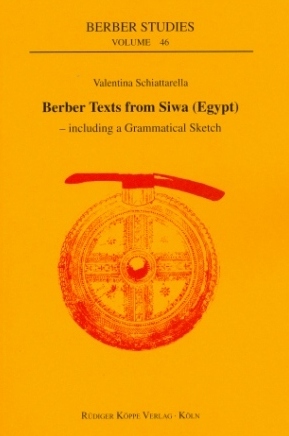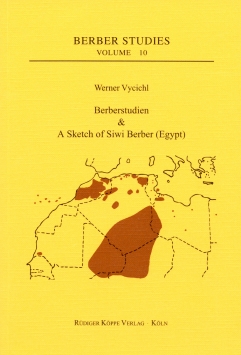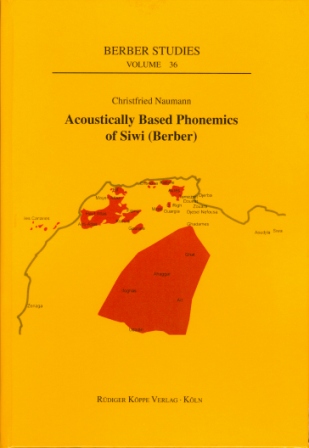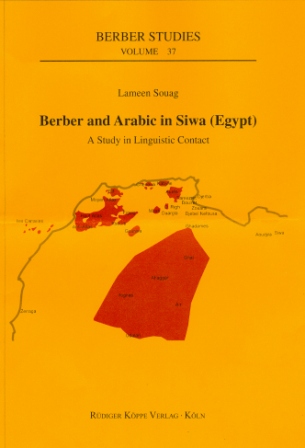



Berber Texts from Siwa (Egypt)
– including a Grammatical Sketch. With a Foreword by Lionel Galand
Author: Valentina Schiattarella. With a preface by: Lionel Galand †. Series edited by: Harry Stroomer.
Series: BS Berber Studies Volume 46
2017200 pp.
2nd, completely revised edition
Text language(s): English
Format: 160 x 240 mm
400 g
Paperback
€ 49.80
Buy 'Berber Texts from Siwa (Egypt)' as a downloadable PDF document directly from our online shop »
Order 'Berber Texts from Siwa (Egypt)' as print edition »
The Siwi language is usually considered to be a variety belonging to the oriental group of Berber languages together with the Libyan varieties of Ghadames, Sokna, Awjilah and El Fogaha. Several voyagers and scholars have already collected data on Siwi, but their publications are either out-of-date or restricted to specific problems. The author managed to give us a book which no doubt deserves to draw the attention of all those who have an interest in Berber languages and culture in general or in North Africa as a whole.
Linguists, in the first place, will appreciate having a simple and clear grammatical survey and long texts in a single volume. Siwi has undergone an important evolution and adopted new features, but at the same time it has kept ancient ones, which makes it even more interesting. The richness of the data will help comparing Siwi with the other ‘oriental’ dialects of Berber and decide whether or not they can be viewed as a subgroup.
In Siwa storytelling has always been the domain of women, at least in the past. Traditionally the storyteller sat on the floor on carpets and pillows and was often surrounded by children, however adults were not excluded. The aim of the stories was not only to entertain children but also to hand down a pedagogical and instructional message. Many people have confirmed that this kind of ritual has now almost completely disappeared, mainly because of television which has replaced the women’s role of entertaining and teaching children.
This volume is divided into three parts: the first one is a short introduction to the Siwa oasis; the second one is composed of a sketch grammar of Siwi which is meant to help the reader to acquire basic grammatical knowledge on the language. The third part is a collection of nineteen texts: four descriptive narrations, fourteen tales and some riddles. Most of the texts present the Siwi version on the left and the English translation on the right. The last five texts are morpho-syntactically glossed and translated: they are intended to initiate the reader to the structure of Siwi Berber.
Due to its large success, this text collection appereared in a second, completely revised edition in 2017.
In the same series another grammatical sketch and two studies of the phonology of Siwi Berber and of language contact between Siwi and Arabic have been published. Furthermore, an ethnographic account of craftsmanship and architecture in Siwa is available. Following the link below you will find a review of the book by Daniela Merolla:
Accompanying material:
- Acoustically Based Phonemics of Siwi (Berber)
(ISBN 978-3-89645-936-7 ) - Berber and Arabic in Siwa (Egypt)
(ISBN 978-3-89645-937-4 ) - Berberstudien & A Sketch of Siwi Berber (Egypt)
(ISBN 978-3-89645-389-1 )
Cross-reference:
Reviews
La collecte de textes oraux, bien développée dans le champ des études berbères, se focalise habituellement sur les régions berbérophones de l’Algérie et du Maroc. Les études existantes sur le berbère de l’oasis de Siwa en Égypte—notamment Vycichl (2005)— présentent des aspects grammaticaux spécifiques ou généraux avec quelques textes don’t les plus récents, recueillis parmi des hommes, apparaissent dans le volume sur le contact linguistique de Souag (2013). Cela renforce l’intérêt de l’ouvrage de Schiattarella sur le berbère de Siwa, qui vient renforcer la remarquable série des études berbères publié chez Rüdiger Köppe, sous la direction de Harry Stroomer. Les 18 textes (contes, devinettes et descriptions ethnographiques) sont introduits par une présentation générale de 10 pages et une première étude grammaticale de 40 pages environ. […]
La présentation des textes oraux est simple et concise, mais offer les données de référence essentielles sur la situation narrative et sur l’utilisation des formules d’ouverture et de clôture qui caractérisent la récitation de contes en berbère […]
En conclusion, le lecteur peut remercier Schiattarella pour ce volume qui illustre non seulement la grammaire de la langue de Siwa mais aussi une pratique narrative berbère toujours vivante et encore à explorer.
Daniela Merolla in LLA Linguistique & Langues Africaines, 5/2019, 123-124
PDF documents:
 | Review by Daniela Merolla in LLA Linguistique & Langues Africaines 5/2019, 123-124 | (≈ 166 kB) |
| « back | Print version | [top] |
 Books
Books Audio
Audio Biographies
Biographies Series
Series Festschrifts
Festschrifts Journals
Journals